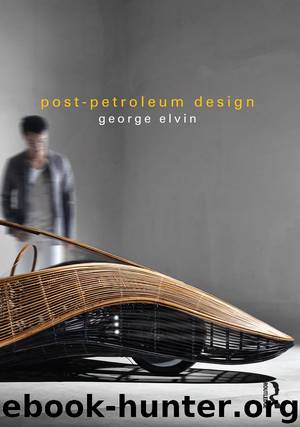Post-Petroleum Design by Elvin George

Author:Elvin, George
Language: eng
Format: epub, mobi
ISBN: 9781317525127
Publisher: Taylor and Francis
Published: 2015-05-15T04:00:00+00:00
Chicken Feather Flower Pot: New Life for a Wasted Resource
Figure 14.8 Chicken Feather Flower Pot
Proving that ingenuity can make almost anything out of anything, the Chicken Feather Flower Pot by Walter Schmidt of the USDA’s Environmental Microbial and Food Safety Laboratory offers a biodegradable alternative to the 500 million plastic flower pots used every year. Image courtesy of U.S. Department of Agriculture.
YOU would expect horticulture to be one of the greenest industries, since it deals with plants. But Mark Teffeau, Director of Research at the Horticultural Research Institute in Washington, D.C., sees a contradiction. “We’re supposed to be a green industry,” he says, “but we have a lot of plastic pots.” A lot as in 500 million per year, according to Gardening magazine. Most are discarded after only one use to avoid cross-contamination between plant species, ending up in the landfill.
But now Walter Schmidt, a research chemist at the U.S. Department of Agriculture’s (USDA) Environmental Microbial and Food Safety Laboratory, has come up with an unlikely alternative. He has been studying chicken feathers for 20 years, and finds them to be a perfect material for flowerpots. Feathers are made from keratin, the same material as fingernails, and are eight times stronger than wood. Sledgehammers and blenders can’t break them down. But when ground with the proper equipment and combined with a naturally occurring polymer, the result is a fully functional, 100 percent biodegradable flowerpot.
Interviewed by NPR at his lab in Beltsville, Maryland, Schmidt mused, “If you figure there are two-and-a-half billion pounds of feathers produced each year, and if their value is comparable to polypropylene, which is like 66 cents a pound, that’s about $2 billion worth of natural resources that are not being harvested.”
Not content to sit in his lab making flowerpots, Schmidt imagines feathers could be used to make building materials, fishing equipment, fertilizer, and BB pellets. And while he has yet to commercialize his feather pots, the prospects are good. Consumer demand for alternatives to petroleum-based pots is up, and a study out of Texas A&M University found that consumers would pay up to 10 cents more for pots made from poultry feathers.7
Download
This site does not store any files on its server. We only index and link to content provided by other sites. Please contact the content providers to delete copyright contents if any and email us, we'll remove relevant links or contents immediately.
POP by Steven Heller(3326)
Japanese Design by Patricia J. Graham(3138)
The Power of Broke by Daymond John(2932)
Architecture 101 by Nicole Bridge(2780)
Indistractable: How to Control Your Attention and Choose Your Life by Nir Eyal(2359)
Fusion 360 for Makers by Lydia Sloan Cline(2334)
Batik by Rudolf Smend(2151)
Actionable Gamification: Beyond Points, Badges, and Leaderboards by Yu-kai Chou(2140)
Origami Art by Michael G. Lafosse & Richard L. Alexander(2080)
Homebody by Joanna Gaines(2047)
Whiskey in a Teacup by Reese Witherspoon(1957)
Worn in New York by Emily Spivack(1946)
Feng Shui by Stephen Skinner(1917)
Austin Kleon by Steal Like an Artist(1904)
Simple Gatherings by Melissa Michaels(1883)
Don't Make Me Think, Revisited: A Common Sense Approach to Web Usability by Steve Krug(1839)
Ryan Korban by Ryan Korban(1735)
Hygge: The Danish Art of Happiness by Marie Tourell Søderberg(1711)
The Joy of Hygge by Jonny Jackson(1706)
